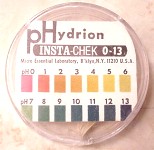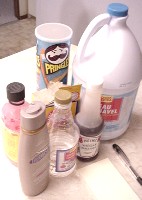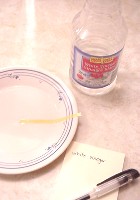 We decided to measure the pH of Pringles' salt & vinegar chips. pH is a measurement of how acidic or basic a substance is, and is measured on a scale of 0 to 14, where values of 0 - 1 denote strong acids, and 13 - 14 denote strong bases. A pH of 7 is neutral. We decided to measure the pH of Pringles' salt & vinegar chips. pH is a measurement of how acidic or basic a substance is, and is measured on a scale of 0 to 14, where values of 0 - 1 denote strong acids, and 13 - 14 denote strong bases. A pH of 7 is neutral.The most common appication of this is when you have excess acid in your stomach, causing 'heartburn'. (It really has nothing to do with your heart ... it's just your stomach acid eating away at your stomach lining). This acid is used to break down food, but too much of it can cause problems. So you take a basic substance, some form of stomach pills like 'Tums', which dissolve in your stomach and combine with some of the acid (making it pH 7 neutral), thus lowering the overall acid content of your stomach. The paper strip in the container shown at the right will measure the pH of a liquid by changing colour. The colour it becomes will indicate the pH, according to the scale on the lid. This is called a universal indicator. Strong acids like battery acid (or stomach acid) will turn the paper strips dark orange or red, indicating a very low pH, perhaps 0, 1, or 2. These substances are dangerous, as they easily dissolve things ... like skin! Alternately, very basic substances, like Drano (drain cleaner) or ammonia, will turn the paper strips dark green or blue, indicating a pH of perhaps 12, 13, or 14. These substances are dangerous too, burning the skin in a manner very similar to acids. Already having been surprised once by the burns resulting from eating too many Pringles, we decided not to mess with these dangerous chemicals ... not even stomach acid (supposing, of course, that we could find someone to bring up some, by eating some three-week old yogurt ... O.K., let's not go there!)
First we tested some distilled water as a control, which should be neutral, and which should have a pH of somewhere around 7. Precision is how finely you can measure something. A ruler with centimetre markings will allow you to measure a pencil to be about 16 cm ... not very precise. If however you use a ruler with millimetre markings (tenths of a centimetre), you can measure the length of the pencil to be 15.7 cm. The second measurement is more precise. Accuracy describes how close a measurement is to the real answer. If we measure PI and get 3.5714, we did it with a high degree of precision, but unfortunately weren't very accurate, because PI is actually about 3.1416
the strip after immersing it, in order to see the true colour it had changed to. The colour of the tip of the strip isn't always easy to distinguish in these photos.
As you can see, the measurements were not at all precise, and not accurate either. Vinegar, for example, actually has a pH value a lot closer to 2-3, rather than 5. However, we were able to distinguish between acids and bases, and there was some diffence in the pH levels of the various acidic substances.
|

